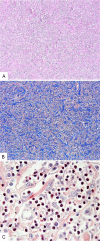Canine eosinophilic pulmonary granulomatosis: case report and literature review
- PMID: 32180541
- PMCID: PMC7081515
- DOI: 10.1177/1040638720907659
Canine eosinophilic pulmonary granulomatosis: case report and literature review
Abstract
We describe and illustrate herein a case of eosinophilic pulmonary granulomatosis (EPG) in a 16-mo-old, castrated male, Great Pyrenees crossbred dog. EPG appears to differ from eosinophilic pneumonias and eosinophilic bronchopneumopathy in dogs by the presence of nodules and masses in the lungs composed of eosinophils, macrophages, and various combinations of lymphocytes, plasma cells, neutrophils, and mast cells within fibrous tissue. Specific information from this dog was added to the information from the limited number of other dogs diagnosed with EPG reported in the veterinary literature, and the information analyzed. EPG appears to have no breed or sex predilection and tends to be a disease of younger dogs, often ≤ 3 y of age. Antemortem imaging of nodules and masses in the lungs, combined with cytologic evidence of eosinophils in the lesions, is highly suggestive of EPG, and the diagnosis can be confirmed postmortem. Concurrent eosinophilia and basophilia can be features of EPG, but their diagnostic value requires further investigation, as does the possible causal association with Dirofilaria immitis infection.
Keywords: dogs; eosinophilic granuloma; lung pathology.
Conflict of interest statement
Figures


Similar articles
-
Four cases of pulmonary nodular eosinophilic granulomatosis in dogs.Cornell Vet. 1983 Jan;73(1):41-51. Cornell Vet. 1983. PMID: 6825452
-
Eosinophilic bronchitis, eosinophilic granuloma, and eosinophilic bronchopneumopathy in 75 dogs (2006-2016).J Vet Intern Med. 2019 Sep;33(5):2217-2226. doi: 10.1111/jvim.15605. Epub 2019 Aug 29. J Vet Intern Med. 2019. PMID: 31468629 Free PMC article.
-
Eosinophilic granulomatous pneumonia in a dog.Vet Rec. 1986 Jun 7;118(23):631-2. doi: 10.1136/vr.118.23.631. Vet Rec. 1986. PMID: 3739155
-
Canine and feline eosinophilic skin diseases.Vet Clin North Am Small Anim Pract. 2006 Jan;36(1):141-60, vii. doi: 10.1016/j.cvsm.2005.09.015. Vet Clin North Am Small Anim Pract. 2006. PMID: 16364781 Review. No abstract available.
-
Selected complications and sequelae of canine heartworm disease.Semin Vet Med Surg Small Anim. 1987 Feb;2(1):56-63. Semin Vet Med Surg Small Anim. 1987. PMID: 3321297 Review. No abstract available.
Cited by
-
A clinical and hematologic approach to basophilia in dogs, cats, and horses.Vet Clin Pathol. 2025 Mar;54(1):24-34. doi: 10.1111/vcp.13404. Epub 2024 Dec 1. Vet Clin Pathol. 2025. PMID: 39617948 Free PMC article.
-
Eosinophilic pulmonary granulomatosis resembling a pulmonary carcinoma in a dog in Hong Kong.Open Vet J. 2022 Sep-Oct;12(5):612-617. doi: 10.5455/OVJ.2022.v12.i5.3. Epub 2022 Sep 5. Open Vet J. 2022. PMID: 36589391 Free PMC article.
-
Feline herpesvirus-1-related multiple respiratory eosinophilic nodules in an adult cat receiving long-term oral prednisolone.JFMS Open Rep. 2024 Jan 30;10(1):20551169231220291. doi: 10.1177/20551169231220291. eCollection 2024 Jan-Jun. JFMS Open Rep. 2024. PMID: 38299191 Free PMC article.
-
Seasonal distribution and environmental parameters associated with Brugia pahangi and Dirofilaria immitis in naturally infected dogs in Bangkok and vicinity, Thailand.Sci Rep. 2021 Feb 25;11(1):4594. doi: 10.1038/s41598-021-84215-8. Sci Rep. 2021. PMID: 33633276 Free PMC article.
References
-
- Blair LS, Campbell WC. Efficacy of ivermectin against Dirofilaria immitis larvae in dogs 31, 60, and 90 days after infection. Am J Vet Res 1980;41:2108. - PubMed
-
- Calvert CA, et al. Pulmonary and disseminated eosinophilic granulomatosis in dogs. J Am Anim Hosp Assoc 1988;24:311–320.
-
- Carroll JM, Simon J. Eosinophilic granuloma in a dog. J Am Vet Med Assoc 1967;150:526–528. - PubMed
-
- Caswell JL, Williams KJ. Respiratory system. In: Maxie MG, ed. Jubb, Kennedy, and Palmer’s Pathology of Domestic Animals. 6th ed. Vol. 2 St. Louis, MO: Elsevier, 2016:465–591.
-
- Clark JN, et al. Efficacy of ivermectin and pyrantel pamoate combined in a chewable formulation against heartworm, hookworm, and ascarid infections in dogs. Am J Vet Res 1992;53:517–520. - PubMed
Publication types
MeSH terms
LinkOut - more resources
Full Text Sources

